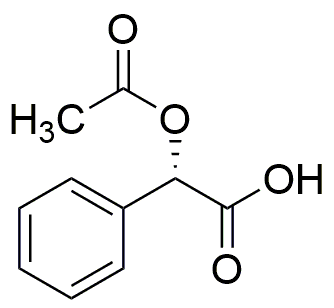(+)-O-Acetyl-L-mandelic acid is widely utilized in research focused on
- Pharmaceutical Development: This compound serves as an important intermediate in the synthesis of various pharmaceuticals, particularly in the development of drugs targeting metabolic disorders.
- Chiral Synthesis: It is used in asymmetric synthesis processes, allowing chemists to create specific enantiomers that are crucial in the production of effective medications.
- Analytical Chemistry: The compound is employed in analytical methods to determine the presence of certain biological molecules, enhancing the accuracy of biochemical assays.
- Cosmetic Formulations: Its properties make it suitable for use in cosmetics, where it can act as a stabilizer or pH adjuster, improving product performance and shelf life.
- Research in Metabolism: Researchers utilize this compound to study metabolic pathways, providing insights into how certain substances are processed in the body, which is vital for drug development and safety assessments.
Informations générales
Propriétés
Sécurité et réglementation
Applications
(+)-O-Acetyl-L-mandelic acid is widely utilized in research focused on
- Pharmaceutical Development: This compound serves as an important intermediate in the synthesis of various pharmaceuticals, particularly in the development of drugs targeting metabolic disorders.
- Chiral Synthesis: It is used in asymmetric synthesis processes, allowing chemists to create specific enantiomers that are crucial in the production of effective medications.
- Analytical Chemistry: The compound is employed in analytical methods to determine the presence of certain biological molecules, enhancing the accuracy of biochemical assays.
- Cosmetic Formulations: Its properties make it suitable for use in cosmetics, where it can act as a stabilizer or pH adjuster, improving product performance and shelf life.
- Research in Metabolism: Researchers utilize this compound to study metabolic pathways, providing insights into how certain substances are processed in the body, which is vital for drug development and safety assessments.
Documents
Fiches de données de sécurité (FDS)
La FDS fournit des informations de sécurité complètes sur la manipulation, le stockage et l’élimination du produit.
Spécifications du produit (PS)
Le PS fournit une description complète des propriétés du produit, notamment sa composition chimique, son état physique, sa pureté et les exigences de stockage. Il détaille également les plages de qualité acceptables et les applications prévues du produit.
Certificats d'analyse (COA)
Recherchez des certificats d'analyse (COA) en saisissant le numéro de lot du produit. Les numéros de lot et de lot se trouvent sur l'étiquette d'un produit, après les mots « Lot » ou « Lot de fabrication ».
Numéro de catalogue
Numéro de lot/série
Certificats d'origine (COO)
Ce certificat d'exploitation confirme le pays dans lequel le produit a été fabriqué, et détaille également les matériaux et composants utilisés et s'il est issu de sources naturelles, synthétiques ou autres sources spécifiques. Ce certificat peut être requis pour les douanes, le commerce et la conformité réglementaire.
Numéro de catalogue
Numéro de lot/série
Fiches de données de sécurité (FDS)
La FDS fournit des informations de sécurité complètes sur la manipulation, le stockage et l’élimination du produit.
DownloadSpécifications du produit (PS)
Le PS fournit une description complète des propriétés du produit, notamment sa composition chimique, son état physique, sa pureté et les exigences de stockage. Il détaille également les plages de qualité acceptables et les applications prévues du produit.
DownloadCertificats d'analyse (COA)
Recherchez des certificats d'analyse (COA) en saisissant le numéro de lot du produit. Les numéros de lot et de lot se trouvent sur l'étiquette d'un produit, après les mots « Lot » ou « Lot de fabrication ».
Numéro de catalogue
Numéro de lot/série
Certificats d'origine (COO)
Ce certificat d'exploitation confirme le pays dans lequel le produit a été fabriqué, et détaille également les matériaux et composants utilisés et s'il est issu de sources naturelles, synthétiques ou autres sources spécifiques. Ce certificat peut être requis pour les douanes, le commerce et la conformité réglementaire.


